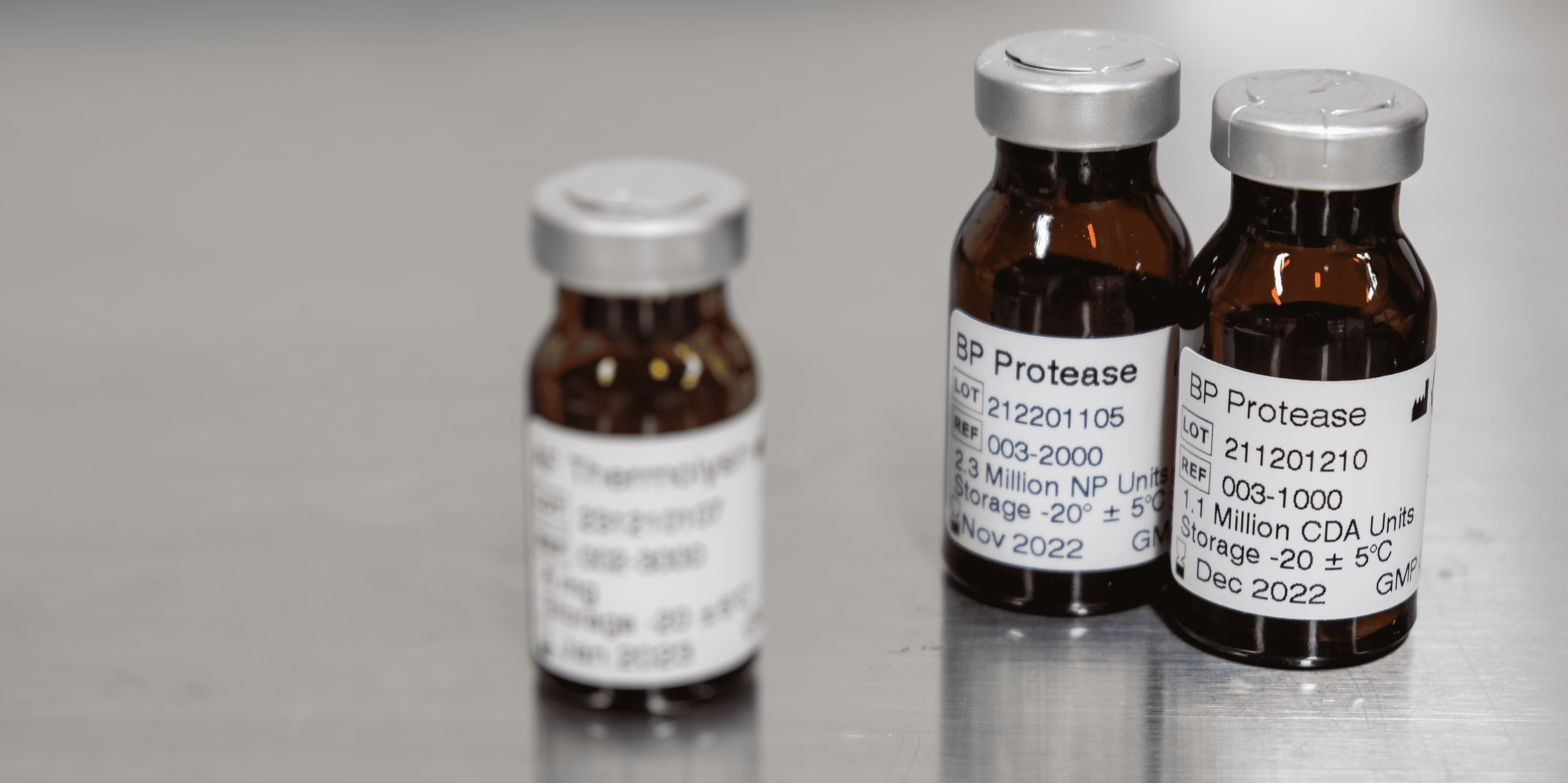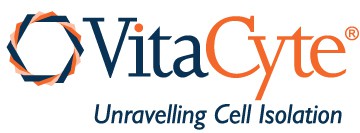
The selection and dose of neutral protease used for cell isolation is the critical factor that controls the outcome from a cell isolation procedure if and only if there is an excess of collagenase collagen degrading activity in the enzyme mixture. The primary function of collagenase is to strip a sufficient number of tropocollagen molecules from collagen fibrils or fibers,[1] loosening the extracellular matrix and enabling the appearance of protease sensitive sites on the extracellular matrix (ECM) proteins, leading to cleavage of the proteins by endogenous or exogeneous proteases found in the tissue dissociation enzyme mixture. When a sufficient number of these ECM cell anchoring proteins are cut, cells are released from the tissue.[2]
There are only a few publications that analyze the impact of protease on cell isolation outcomes for two reasons. First, the biochemical characteristics of the collagenase-protease enzyme mixtures used in many studies is incomplete, confounding the interpretation of the results. Second, the cell isolator needs the active participation of an enzyme supplier in the experimental design to ensure the proper interpretation of the results.
The importance of the selection of an appropriate neutral protease was shown by Balamurugan N. Appakalai (i.e., Bala) and colleagues at the University of Minnesota. Bala achieved respectful human islet yields when using VitaCyte’s Thermolysin with purified Collagenase HA for human islet isolation.[3] However, Bala believed that Clostridium histolyticum neutral protease (CHNP) was superior to Thermolysin for human islet isolation based on his earlier work with Rita Bottino at the University of Pittsburgh where they showed the best quality islets were those isolated using Roche’s Collagenase P product. This observation led Bala to prepare a “new enzyme mixture” (NEM), composed of VitaCyte’s Collagenase HA with Serva/Nordmark’s NB Protease (CHNP).[4] The enzyme dose used for isolation was 18-20 Wunsch U of collagenase and 1.25-1.5 DMC U of CHNP per g of trimmed pancreas. Analysis of results from 90 islet isolations using eight different commercial enzyme mixtures showed that islets isolated with NEM gave shorter digestion times, higher recovery of purified islets expressed as total IEQ/pancreas and per g pancreas than nearly all of the enzyme mixtures used for comparison. Further experiments compared the effectiveness of CHNP or thermolysin mixed with a fixed dose of VitaCyte’s Collagenase HA to recover islets from a split human pancreas.[4] These results showed that NEM gave significantly higher total purified islet yields and a higher percentage of islets with mean diameters > 200 μm. Analysis of these data, expressed as IEQ per g pancreas, was not significantly different likely because of the small number of experiments performed to compare the performance of these enzymes.
Further collaborative studies with Bala and his UMN colleagues with VitaCyte led to the evaluation of VitaCyte’s purified BP Protease (a Dispase™ equivalent enzyme) for human islet isolation. The BP Protease activity used per g of tissue (23,400 neutral protease U) was equivalent to the activity used in an updated NEM formulation (1.75 DMC U/g tissue). The initial studies used a fixed amount of BP Protease with one of four different doses of recombinant C. histolyticum class I and class II. These results showed that collagenase was in excess, the dose did not affect the recovery of functional islets from the body-tail of human pancreas.[5] Further studies by Bala and colleagues at the University of Louisville using intact pancreas showed that this dose of BP Protease was very effective in recovering islets when excess purified recombinant or natural collagenase was used in the isolation procedure.[6] The mean islet yield per g tissue from all the studies above was 5,309 IEQ when either excess purified recombinant or natural collagenase with a fixed dose of 23,400 NP U of BP Protease. These results are summarized in the table below.
Enzyme Mixture |
Reference |
WU/g Pancreas |
mg Collagenase/g Pancreas |
n |
Islet Yield/g Pancreas± one std dev |
|---|---|---|---|---|---|
| rC1 + rC2 | (5) | 12 or 20 | 2.09-3.75 | 12 | 5209 ± 1809 |
| rC1 + rC2 | (6) | 12 | 2.09 | 7 | 5455 ± 918 |
| rC1 + rC2 | (6) | 20 | 3.48 | 5 | 5535 ± 830 |
| Collagenase HA | (6) | 20 | 4.41 | 8 | 4946 ± 974 |
rC1 or rC2 = Recombinant collagenase
Collagenase HA = Purified natural collagenase with 60:40 C1:C2 ratio
The average islet yield of approximately 5,000 IEQ/g pancreas is a very respectable value since these numbers were achieved by 52.5% of the human islet isolation performed as part of the clinical Islet Transplantation Consortium clinical trials.[7]
References
[1] Sakon J, McCarthy RC. Webinar: Collagen degradation by Clostridium histolyticum collagenases (2021) https://www.vitacyte.com/collagen-degradation-by-clostridial-histolyticum-collagenases/
[2] McCarthy RC, Green ML, Dwulet FE. Evolution of Enzyme Requirements for Human Islet Isolation. (2018) OBM Transplantation 2(4):024; doi:10.21926/obm.transplant.1804024.
[3] Balamurugan AN, Breite AG, Anazawa T, et al. Successful human islet isolation and transplantation indicating the importance of class 1 collagenase and collagen degradation activity assay. (2010) Transplantation 89(8):954-61.
[4] Balamurugan AN, Loganathan G, Bellin MD, et al. A new enzyme mixture to increase the yield and transplant rate of autologous and allogeneic human islet products. (2012) Transplantation. 93(7):693-702.
[5] Balamurugan AN, Green, ML, Breite, AG, et al. (2015). Identifying Effective Enzyme Activity Targets for Recombinant Class I and Class II Collagenase for Successful Human Islet Isolation. Transplantation Direct. 2. 1. 10.1097/TXD.0000000000000563.
[6] Loganathan G, Subhashree V, Breite AG, et al. Beneficial effect of recombinant rC1rC2 collagenases on human islet function: Efficacy of low‐dose enzymes on pancreas digestion and yield. (2018) Am J Transplant 18:478–485. https://doi.org/10.1111/ajt.14542.
[7] Ricordi C, Goldstein J, Balamurugan AN, et al. National Institutes of Health-Sponsored clinical islet transplantation consortium Phase 3 trial: Manufacture of a complex cellular product at eight processing facilities. (2016) Diabetes 65:3418-3428.
